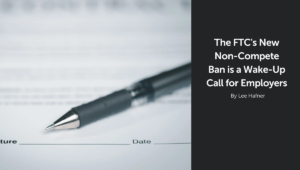One morning in late March 2020, 406 employees at Bird, the electric scooter company, received a routine-sounding calendar invite titled “COVID-19 Update.” At the appointed time, they logged on, finding that — in contrast to most company meetings — their cameras and microphones had been turned off. After staring at a gray screen for several minutes, employees were greeted by a “robotic-sounding, disembodied voice” informing them that their positions had been eliminated. Soon after the shell-shocked employees logged off, their company-issued laptops went dark. “It felt like a Black Mirror episode,” one former employee said.
Bird isn’t the only company that has recently sparked outrage for its callous treatment of employees during layoffs. And with half of U.S. executives in a recent survey planning to reduce their head count in coming months, many more risk joining the ranks. Although it’s impossible to make a layoff conversation anything but painful, the way layoffs are communicated has a massive ripple effect because it impacts dismissed employees, remaining workers, and public perception of the company. Therefore, it’s important to use neuroscience to handle layoffs with care.
Layoffs Affect Everyone
It’s common for the person being laid off to experience a range of emotions, beginning with shock or disbelief and progressing to anger, betrayal, and sorrow. In the span of a few seconds, their life dramatically changes: How will they pay the rent or mortgage? How can they support their family? What about that vacation they’d been planning? Suddenly, a normal workday becomes one of the worst days of their lives.
According to a 2022 survey, 40% of Americans have been laid off or terminated from a job at least once. People who experience layoffs often suffer from declines in mental and physical health, and even after they’ve found another job, they report greater job insecurity, distrust of their employer, and intentions to leave.
Meanwhile, people who remain at the company may feel an immediate sense of relief that their job — for the time being — is safe. However, layoff survivors often experience heightened job insecurity when they realize the same thing could happen to them. In one study, remaining workers reported a 41% decrease in job satisfaction, a 36% decline in organizational commitment, and a 20% decrease in job performance. What’s more, research shows that downsizing a workforce by just 1% leads to a 31% increase in voluntary turnover the next year – creating a significant amount of collateral damage.
Although the person doing the layoffs garners the least sympathy, being in this position isn’t easy. Those charged with delivering the bad news often feel high levels of stress, guilt, and sorrow. Some cope with these feelings by emotionally distancing themselves from the task and the employee, rushing through the conversation or reframing it as a normal part of work, rather than as a life-changing event for the person being let go. But from the employee’s standpoint, a lack of empathy signals that the employer never truly valued or cared about them, which makes them feel even worse about their situation.
Making an Overwhelming Threat Manageable
When layoffs are handled with care, the employee feels they’ve been treated fairly and with dignity. Rather than being mired in negative emotions, they’re able to focus on the task of gaining new employment. They can even adopt a growth mindset that allows them to explore opportunities they may not have previously considered. They’ll also be less likely to retaliate by speaking negatively about the company to others. And they might even be open to returning to the company in the future as a “boomerang employee.”
The goal for every leader who must dismiss an employee is to deliver the news in a way that turns an overwhelming threat into a manageable one. They can do so by understanding the SCARF® model, which was developed by NLI more than a decade ago to describe the five domains of social threat and reward: Status, Certainty, Autonomy, Relatedness, and Fairness. Notably, being laid off threatens every one of these domains, which is why it’s such an emotionally intense experience. Luckily, leaders can soften the blow by sending rewards to these same domains. Here’s how:
Status
Being told they’re no longer wanted or needed at a company is a major blow to a person’s status. Scheduling a one-on-one conversation, rather than a mass layoff, will demonstrate that the employee is valued and respected as an individual. It will also give them the opportunity to respond and ask questions. If the decision was not a reflection of the employee’s work, the employer should be sure to say so and offer to provide glowing references.
A great example of how leaders can reinforce employees’ status is in the heartfelt letter Airbnb CEO Brian Chesky wrote to employees to communicate the company’s decision to lay off 25% of its workforce in May 2020: “The result is that we will have to part with teammates that we love and value. We have great people leaving Airbnb, and other companies will be lucky to have them.”
Certainty
One of the worst things about losing a job is the lack of certainty about one’s next steps. By clearly communicating what comes next, employers can throw a life preserver to laid-off employees adrift in a sea of uncertainty.
To help Airbnb’s laid-off employees prepare for their next role, the company offered several forms of job support, such as an alumni talent directory, where laid-off employees could post profiles, resumes, and work samples for potential employers; an alumni placement team, which tasked AirBnB recruiters with helping laid-off employees find their next job; and the ability to keep their company laptops to assist with the job search.
Autonomy
Nothing makes a person feel more powerless than being told their source of income is being taken away. To help people regain a sense of control, offer them some unexpected choices. For example, would they prefer to work full-time for another month, or half-time for two months to allow time to look for another job? Or perhaps they would like to be involved in communicating their layoff to the rest of the company? Even seemingly small choices can help restore a laid-off employee’s sense of autonomy.
Relatedness
When employees — both those leaving and remaining — feel their company truly cares about them, they’re better able to weather tough times. In his letter, Airbnb did a commendable job of encouraging this relatedness by offering a program in which remaining employees could volunteer to assist their departing teammates in finding new roles.
Chesky’s letter also included the following: “To those of you staying, one of the most important ways we can honor those who are leaving is for them to know that their contributions mattered, and that they will always be part of Airbnb’s story.” This statement helped former and current employees feel a sense of belonging and relatedness.
After layoffs, leaders should check in with remaining employees by holding open forums or listening sessions to discuss concerns.
Fairness
Research indicates that when employees perceive they’re being treated fairly, they can better cope with job losses. In addition, the perception of fairness helps remaining employees have higher morale and performance.
There are three major types of fairness: distributive, procedural, and interactional. Employers can satisfy each of these by providing support and resources (distributive), communicating decisions in a transparent, logical manner (procedural), and showing concern for the employee’s dignity and well-being (interactional).
After receiving backlash on social media, Bird founder Travis VanderZanden tweeted that the Zoom layoff was “not ideal.” He admitted that, in retrospect, the company should’ve made one-on-one calls to the hundreds of impacted employees over the course of a few days. Such an approach would have gone a long way toward compensating SCARF domains that are so strongly threatened when an employee learns they’ve been let go.






